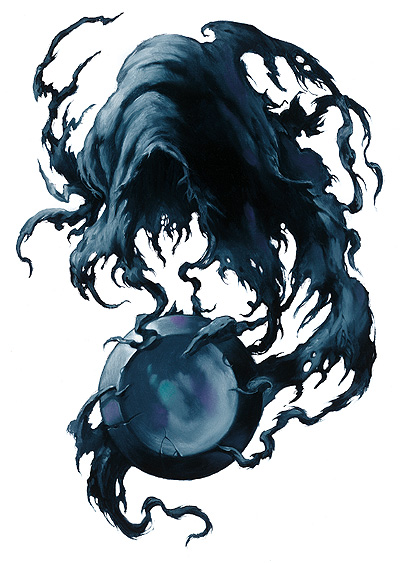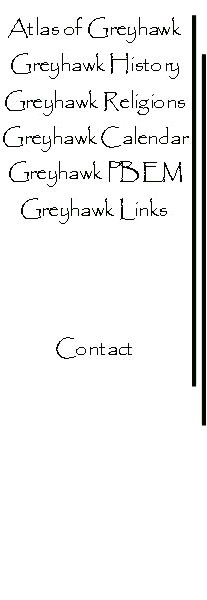


Characteristics of the
Races
Inhabiting the Flanaess
here are few pure racial groups existant on the Flanaess, save perhaps at the fringe areas of the continent. Of course, the races of the demi-humans are relatively unmixed, but humankind, as is its wont, has industriously intermixed in the central regions to form a hybrid type which has actually become the norm.
Baklunish: The Baklunish people have golden-hued skin tones. Eye color is commonly gray-green or green, with gray uncommon and hazel rare. Hair color ranges from blue-black to dark brown. Ekbir, the Tiger Nomads, Ull, and Zeif typify the straight Bakluish strain. The VVolf Nomads are intermarried with the Rovers of the Barrens, so they show the darker Flan blood. Ket is so mixed with Suel and Oeridian blood as to be the least typical of the Baklunish race, for the people of Ket are pale yellow or golden-brown or tan in skin color, with virtually any hair color possible save the lightest yellows and reds. Both the Paynim tribes and Tusmit show occasional admixture, also.
Flannae: The Flan race have a bronze-colored complexion. This varies from a lighter, almost copper shade to a very dark tone which is deepest brown. Eye color is commoitly dark brown, black, brown, or amber (in declining order of occurrence). Hair coloration is black, brown-black, dark brown, or brown. Also, Flannae tend to have wavy or curly hair. People of the Duchy of Tenh are pure Flan, proud of their bronze color. Geoff and Stench, despite mixture show strong Flan racial influence. The Rovers of the Barrens are of the copper-toned sort of Flannae, although the western tribes show the golden skin color of the Baklunish due to interbreeding with the Wolf Nomad tribes. The people of the Hold of Stone Fist and the citizens of the Theocracy of the Pale are primarily hybrids, the former Flan/Suel, the latter Flan/Oeridian. The inhabitants of the Pale are particularly handsome.
Oeridians: The Oeridians have skin tones ranging from tan to olive. They have hair which runs the gamut of color from honey blonde to black, although brown and reddish brown are most common. Likewise, eye coloration is highly variable, although brown and gray are frequently seen in individuals. Unmixed Oeridians, despite claims of the Great Kingdoni, are most common in Furyondy, Perrenland, the Shield Lands, and in the east and south in North Province, Medegia, and Onnwal and Sunndi.
Suloise: 't'he fleeing Suel folk were scattered in a broadcast fashion across the Flanaess, so that most tended to mix with other groups. The Suel race is very fair-skinned, some being almost albino. They have light red, yellow, blond, or platinum blonde hair. Eye color varies from pale blue or violet through deep blue, with gray occasionally occurring. Curly to kinky hair is common. The inhabitants of the Duchy of Ernst are nearly of pure Suel race. The Frost, Ice, and Snow Barbarians are perfect specimens of unmixed Suloise blood; the nearly albinoid Snow Barbarians are the best example. The Suel folk are quite predominant in the island groups off the eastern coast of the Flanaess as well as on Tilvanot Peninsula, in the Scarlet Brotherhood region. Those bands that migrated into the vast Amedio Jungle and Hepmonaland are so altered as to be no longer typical of the race; they are tan to brown with heavy freckling.
The predominant racial strain and particular admixtures of each of the major states of the Flanaess is given in the list which follows. The first letter is the predominant strain. Thus, "OSf" would mean an admixture of Oeridian with a strong Suel strain and a weak Flan mix, as the "f" is uncapitalized. Had it been "OSF" (with a capital F), the indication would be that the Flan influence was only scarcely less than that of the Suel.
Almor - OS Ratik - Sof Bandit Kingdoms - OFSb Rel Astra - Os Bissel - OSB Sea Barons - So Bone March - (SO) Sea Princes - SOf Dyvers - OSfb South Province - Os Gran March - SOf Spindrift Isles - So Great Kingdom - OS Stench - OFS Greyhawk - OSfb Ulek, County - OFS Highfolk - Os Ulek, Duchy - (Sfo) Idee - OS Ulek, Principality - (SO) Irongate - Os Urnst, County - SO Keoland - Sof Valley of the Mage - OBf Lordship of the Isles - So Veluna - Osf Nyrond - Os Verbobonc - Ofs Pomarj - (SO) Wild Coast - Sof Yeomanry - SOf
The inmixture of Ocridian and Suel is expressed as (SO) in the list. The original Flannae stock Shows up with either Oeridian or Suloise or both as a coppery or bronze overtone. Oeridian and Baklunish develops a fairly light complexion, but the skin coloration is true yellow. A hybrid of Baklunish and Flannae gives a golden-copper or golden-bronze color which is possibly the most attractive complexion of any of the admixtures of the basic races.
In general, the skin color of an individual is of no particular importance. The dark Flan complexion shows up quite often in most nations. By contrast, the nobles of the Great Kingdom are proud of being light-skinned, just as the rulers of Tenh are overly conscious of the supposed superiority of their deep bronze color. In the central region of the Flanaess, from western Urnst Duchy to Geoff, there is little heed paid to either skin color or racial type, whether human or demi-human (or even humanoid, in some places). The main exception to this is the demi-human kingdoms, where humankind is judged inferior, especially in Celene.
acial and National Dress
Oeridians typically favor checks and plaids. Aerdi and Nyrondal houses tend to wear plaids, while the southern and western Oeridians favor checks, often of a diamond pattern or similar variation from the standard square. Clothing tends toward tight-legged trousers, close-fitting upper garments, and capes or cloaks.
Suloise folk have long used solid colors. Aristocratic houses have two or more such colors in their dress, so parti-colored garments are not uncommon. Similarly, the Suel people tend to favor display of emblems or tokens on their garments, typically of a contrasting color to their basic one. Dress was originally loose pantaloons topped by a baggy blouse. This form of dress has heen changed to meet the needs of the varying climates, so the nonhern Suloise barbarians wear furs and skin garments, while those in the southern-most area have replaced the blouse with vest-like upper wear.
Flannae once wore brightly-hued body paints, with yellow ochre and vermilion being the favorites. While the Rovers of the Barrens still use considerable body painting (where their high boots, loincloth and chest and arm leather don't cover them), the more civilized Flan dress in the mode currently fashionable in their portion of the continent. Garments, however, tend to be of solid primary colors, with very bright hues predominant.
Baklunish peoples are of two sorts. The northern branch favors bright patterns and gaudy colors. They wear gowns and robes, or else short breeks and flowing coats. The poorer folk even wear gaudy prints, although their garments are typically a one-piece coverall with whatever additional garb they can add. The southern branch likes parti-colors of a more pastel hue. Their dress is complex and full of many puffs and slashes when adorned for special events. They commonly wear rough hide and cloth when traveling or at war, with shields and banners showing clan colors.
Dwarven folk love shades of brown, red, and gray contrasted with a bright splash of color and picked out with as much precious metal as they can possibly wear. Leather is a favorite material, with wool being popular also. Dwarves wear clothing similar to that of the Oeridians.
Elves of the Sylvan ilk dress similiar to Suloise, except their colors are pale tints of green, fawn, ecru, and dove gray. High elves are similar in mode of apparel, but they add blues, lilacs, and purples to the more natural forest hues of their woodland kin. Hunting and war garments are brown, russet, or tan. Gray elves wear very complex and flowing garb of pure white, sun yellow, silver and gold lame' set off by polished leather of contrasting colors and highlighted by jewels. All elvenkind wear cloaks, especially when traveling. These garments are neutral gray or gray-green.
Gnomes and halflings dress in a similar fashion, often replacing their trousers with knee-length britches. The gnomes favor more stolid colors - brown breeks, a tan blouse, green boots and belt, with a dark brown jacket or coat. A halfling in the same garb might have a yellow shirt and top off with a cap of green with a bright yellow feather in it. Both races will often wear striped clothing. When hunting or at war, they likewise favor garb of a curiously mottled sort, with greens and browns intermixed.